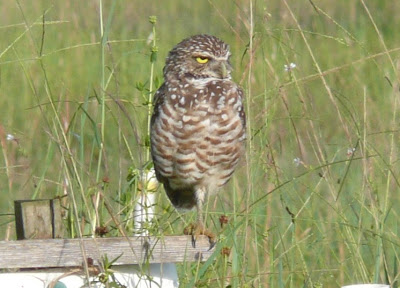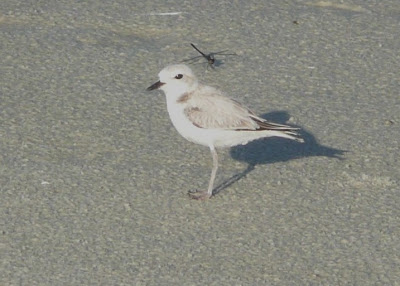Upland Plovers - Everglades Ag Area
August 16th
 |
| Common Nighthawk - at least three dozen found on wires in Ag Area |
Used my only day off this week to re-bird the Everglades Agricultural Area in Palm Beach County today. I had searched the area about three weeks ago with little success, but August is supposed to be the prime time to search for migrating shorebirds. My targets for today were upland sandpipers and american avocets. However I was handicapped with a lack of a viewing scope. This is a must for viewing here.
Started out from home before dawn with my intention to be on-site by nine o'clock. Following sunrise my first good birds of the day were a trio of Black-necked Stilts working the flooded areas in a road construction area east of LaBelle on Rt 80. About twenty miles further came across a family of four Crested Caracara sitting in a snag with one of the adults feeding a juvenile. Cool!!
CLEWISTON - Checked out Griffin Road, which is in the sugar cane fields west of Clewiston. Came up with a pair of Eastern Kingbirds, several Barn Swallows and a couple of resting Common Nighthawks. Seemed to be hundreds of Red-winged Blackbirds in the cane.
Absent from when I came through the Clewiston area three weeks ago there the dozens of swallow-tailed kites, but now the skies are clear. None to be seen. Guess they are already in South America.
Spent a few minutes looking for the common mynas that are supposed be found around the McDonald's shopping center area. None seen today, just a lot of Boat-tailed Grackles, Rock Pigeons, House Sparrows and Fish Crows. The usual urban bird crowd.
CEDAR GROVE - A stand of cypress, known as the cedar stand is located at the western end of CR-827 and the Miami Canal. The grove is noted as a reliable barn owl roost. Being one of my nemesis birds I had to give the grove another visit. The eight mile road is a narrow lane strip atop an elevated roadway with steep embankments descending on both sides of the road to parallel canals, within the cane fields
. Many red-winged blackbirds and grackles were active along the road, passed a snag that was home to several Green Herons, but I was pleasantly surprised to find a King Rail, LIFER, standing in the road. It quickly moved into concealment. I had heard king rails several times before, but it was my first sighting. Cool!!
The barn owls status as a nemesis bird held up as I could not locate any today. Besides the this tree stand, barn owl nest boxes are seen all around this area. In the cane fields and peoples yards. Suppose they help keep down the vermin. Other birds seen though were a Red-Shouldered Hawk, more resting nighthawks, and barn swallows. A Yellow Warbler could be heard within the grove and as I was exiting the area had a brief glimpse of another one.
The SOD FARM - Next was to head over to CR-880 and Brown's Farm Road to look for shorebirds. The sod fields noted in a posting on the
Tropical Audubon Society message board from the yesterday had thirty-six upland sandpipers , plus a long list of other species and I easily located the site. It is along CR-880 just east from the Brown Farm's Road intersection. Had arrived about 9:30 am and found the fields to be very active with
Wood Storks,
Great Egrets, Snowy Egrets, White and
Glossy Ibis, many
Killdeer and
Laughing Gulls. Needed a scope here to improve my evaluation of the birds. One bird I could not make out was any upland sandpipers. After about a half hour I chose to check out Brown's farm Road and would recheck the sod field afterward.
Brown's Farm Road was a disappointment. Found few flooded fields and only managed a couple of Killdeer and a lone Lesser Yellowlegs. Common Nighthawks were seen on the wires, more red-winged blackbirds were active as were boat-tailed grackles and barn swallows. Turkey and Black Vultures were soaring as the day was heating up.
A small green single prop airplane was actively buzzing the fields, probably dusting, which does not help with birding.
Arriving back at the sod fields, found all of the birds were gone. Probably due to the airplane's flight. However, I did find three of my target sandpipers. Why the Upland Sandpipers were present when everything else had left was an interesting question. They probably just arrived or returned. Way too far for my camera to get a photograph, but in the picture below of the field three small brown dots can be seen.
 |
| Sod field where three Upland Sandpipers were located. |
BLUMBERG ROAD - With having located a king rail and having my best looks ever of upland sandpipers I started for for home, as I did have to prep (nap) for work tonight.
However, just before reaching clewiston , I elected to check the Blumberg Road area by heading south from US 27 to CR-835 on a hunch that I could find an avocet in the area of Stormwater Treatment Area #5 (STA5). This is also when I finally found a couple of
Swallow-tailed Kites soaring over the road. They were my only sitings and could have been my final looks at the kites for the season.
Along Blumberg Road, I finally found a flooded field containing shorebirds. Wood storks, egrets, herons Black-Necked Stilts, white and glossy ibis, many Lesser and
Greater Yellowlegs, plus several W
estern and
Least Sandpipers. My viewing was limited to a side road I was using, which was not posted, but was probably private so I did not stay long.
But several miles further up the road I came across what I had been searching for. An extensively flooded fields containing a great many wetlands birds. Again I really needed a scope, but I did the best I could. Found great egrets, snowy egrets, Tricolored Herons, and about forty Roseate Spoonbills. Also seen were a pair of Gull-billed Terns and three Black Terns resting together on a log. There were many more yellowlegs, white ibis, glossy ibis and black-necked stilts. Had alone Belted Kingfisher and an Osprey. Was able to id a single Pectoral Sandpiper and several dowitchers, which had at least a few Long-billed Dowitchers based on their call. Was surprised to finally find a pair of American Avocets.
Headed to the end of the road at the gate to STA5 were a Snail Kite is perched atop a pole just inside the property dining on an apple snail. Cool!! From here, headed for home and was able to spot another snail kite above marsh in Collier County, plus a couple of Limpkins and alone Black-bellied Whistling Duck along CR-833. Turned out to be a good trip.
My list - (53)
Black-bellied Whistling-Duck, Mottled Duck, Double-crested Cormorant, Anhinga, Great Egret, Snowy Egret, Tricolored Heron, Cattle Egret, Green Heron, Black-crowned Night-Heron, White Ibis, Glossy Ibis, Roseate Spoonbill, Common Moorhen, Limpkin, Wood Stork, King Rail, Killdeer, Black-necked Stilt, American Avocet, Greater Yellowlegs, Lesser Yellowlegs, Marbled Godwit, Western Sandpiper, Least Sandpiper, Pectoral Sandpiper, Upland Sandpiper, Long-billed Dowitcher, Red-shouldered Hawk, Snail Kite, Swallow-tailed Kite, Crested Caracara, Laughing Gull, Gull-billed Tern, Black Tern, Chimney Swift, Rock Pigeon, Mourning Dove, Common Ground-Dove, Fish Crow, Belted Kingfisher, Rock Pigeon, Mourning Dove, Common Ground-Dove, Common Nighthawk, Eastern Kingbird, Barn Swallow, Yellow Warbler, Northern Cardinal, Boat-tailed Grackle, Red-winged Blackbird, House Sparrow, European Starling


















































